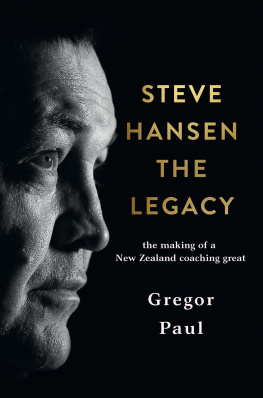Jane Liddiard - Tag Rugby: Everything You Need to Know to Play and Coach
Here you can read online Jane Liddiard - Tag Rugby: Everything You Need to Know to Play and Coach full text of the book (entire story) in english for free. Download pdf and epub, get meaning, cover and reviews about this ebook. year: 2019, publisher: Bloomsbury Publishing, genre: Children. Description of the work, (preface) as well as reviews are available. Best literature library LitArk.com created for fans of good reading and offers a wide selection of genres:
Romance novel
Science fiction
Adventure
Detective
Science
History
Home and family
Prose
Art
Politics
Computer
Non-fiction
Religion
Business
Children
Humor
Choose a favorite category and find really read worthwhile books. Enjoy immersion in the world of imagination, feel the emotions of the characters or learn something new for yourself, make an fascinating discovery.
- Book:Tag Rugby: Everything You Need to Know to Play and Coach
- Author:
- Publisher:Bloomsbury Publishing
- Genre:
- Year:2019
- Rating:3 / 5
- Favourites:Add to favourites
- Your mark:
- 60
- 1
- 2
- 3
- 4
- 5
Tag Rugby: Everything You Need to Know to Play and Coach: summary, description and annotation
We offer to read an annotation, description, summary or preface (depends on what the author of the book "Tag Rugby: Everything You Need to Know to Play and Coach" wrote himself). If you haven't found the necessary information about the book — write in the comments, we will try to find it.
Tag Rugby: Everything You Need to Know to Play and Coach — read online for free the complete book (whole text) full work
Below is the text of the book, divided by pages. System saving the place of the last page read, allows you to conveniently read the book "Tag Rugby: Everything You Need to Know to Play and Coach" online for free, without having to search again every time where you left off. Put a bookmark, and you can go to the page where you finished reading at any time.
Font size:
Interval:
Bookmark:

For my granddaughter Francesca
With thanks to my editor Kirsty Schaper at Bloomsbury for her help and encouragement; to Imogen Gaunt and Callum Sheppard at Harlequins RFC for their help; and to Jon Burton, former head coach of tag rugby at Salisbury RFC, for his information and advice.
Special thanks go to my husband John for his wonderful patience and unflagging support; Crown copyright material for the National Curriculum is reproduced with the permission of the Controller of HMSO and the Queens Printer for Scotland.

(Page references refer to the print edition.)
All internal photographs The Bridge, with the exception of those on pages: 45, 68, 42 and 155 Tom OBrien/PA Archive/Press Association Images; 89, 20 and the margins throughout Shutterstock; 10, 48 and 68 Andrew Redington RFU/The RFU Collection/Getty Images; 12 Gareth J Spencer/Demotix/Press Association Images; 22 Getty Images; 37 and 156 John Stillwell/PA Archive/Press Association Images; 52 Russell Clarken, Prophoto; 63 David Rogers/Getty Images; 67 Tony Marshall/EMPICS Sport/Press Association Images; 94 Adam Davy/EMPICS Sport/Press Association Images.
The second edition of this popular book contains the most up-to-date rules of play, equipment, exercises and drills, fun and games, tips for coaches and referees, funding and festivals, information about the professional game, and much more.
Rugby has become increasingly popular since England won the World Cup in 2003 and there will certainly be a resurgence of interest again for the eighth Rugby World Cup in 2015, especially as it is being held in England.
Community rugby begins with tag rugby, which can be played safely by girls and boys together as young as five years old. Players then progress to junior and senior rugby, and for the really talented players there is the chance of a place at a rugby academy and then on to the professional game.
The stars of the future depend on this enthusiasm for the game at club and school level. Enthusiasm really is vital for instilling a love of playing the game, as well as for bringing on gifted players. Tag rugby coaches and teachers, both the absolute beginners and those with knowledge of how to play the game, will find this book invaluable. Using clear, simple language, diagrams, exercises and games, as well as lesson plans, all based on the RFUs own rules and instructions, this book will guide you through tag rugby step by step. There are also chapters on refereeing, guidelines for working with children, and health and safety as well as essential information for starting up a club or school team, entering festivals and competitions, playing at local and professional grounds on match days and finding extra funds.
This book will improve your coaching and playing skills and, above all, ensure that tag rugby is immensely enjoyed by both players and spectators alike.
Tag rugby is a safe, non-contact, easy-to-play evasion game suitable for both adults and children, but this book deals with mini tag rugby for Under-8 girls and boys, playing together in the same side, in primary schools and community clubs. It is aimed at teachers (National Curriculum Key Stages 1 and 2), coaches and referees, as well as parents or carers, but is also a good read for anyone interested in playing or watching tag rugby.
Tag rugby is a sport thats suitable for very young children. There are no scrums, no line-outs and no kicking. In the past, young children and their parents have been put off by injuries caused by scrums, mauls and lineouts; such physical activities are now seen as dangerous and inappropriate for young, growing bodies so a primary school/local community version of mini rugby has been specifically devised by the RFU (Rugby Football Union). The enthusiasm of young children will more than make up for their lack of stature, and the game is particularly beneficial for all-round fitness, running and handling skills, fostering team spirit and becoming a good sport. These running and passing skills are vital in the junior and senior game at all levels and will help players of tag rugby to move through the transitional stages to senior rugby.
Midi rugby is the next section up from mini or tag rugby, and is sometimes called transitional rugby. It allows some contact and prepares you for stepping up to youth rugby.
In the senior game the emphasis is very much on physical strength as well as skill and even the backs have very strong physiques now. If youve ever watched a scrum, you cant help but gasp when the referee orders Engage! and the two opposing sides hurl themselves forward to lock neck and shoulders in the front rows. The sheer force of this bone-crunching action always makes me grateful that Im not in that front row myself! The back row players also have very powerful physiques and the days of the skinny winger are over. Players in the professional game have to withstand the physicality of rucks and mauls and frequently suffer injuries, but these are mostly minor in the form of bruising and cuts. However, its fair to say that serious injuries sometimes do occur. Its part of the game but, however exciting these aspects of the game appear to very young players, they are only suitable for adults who spend a great deal of their time training to develop their bodies to withstand such pressure and battering. Young children, whose bones are immature and easily broken, cannot risk injury in this way. Therefore, any part of senior rugby which is considered to be a risk for injury has been taken out of the game for minis.
By avoiding physical contact altogether the fear factor of getting hurt has been removed from tag rugby and this is so important because it allows young players to enjoy the excitement of the game in relative safety. They can become part of Englands fantastic rugby tradition, getting a taste and enthusiasm for the game which will carry over into junior and then senior rugby. Being part of a club or school team is important for the sport because mini and junior rugby will bring youngsters with a particular talent through to the academies and, hopefully, to a professional career. Professional clubs all have their own academies and most of these academy players go on to play for their clubs. Its a great source of talent for the premiership and other leagues and, of course, for the players its a way of getting into professional rugby at the highest level.
Even if young players dont become the talented few, they can go on to play rugby at community club level or simply become passionate supporters, which is just as vital for the success of the game at regional, national and international levels. For example, it was very inspiring to see junior rugby players madly practising their goal kicks the day after Jonny Wilkinsons drop goal secured victory for England in the 2003 Rugby World Cup: they were all dreaming of being future World Cup winners. When international tournaments are being played, such as the Six Nations or the Rugby World Cup, theres always a surge of interest in this sport.
Tag rugby is a non-contact rugby game played between two teams on a rectangular pitch with the aim of scoring tries. The rules are discussed in more detail in . An overall view is as follows.
The numbers for each team are 4 a side for Under 7s on a 12m 20m sized pitch, and six a side for Under 8s on a 22m 45m pitch. Tries are scored by running with the ball from your own half of the pitch into the oppositions half, passing to a fellow team player if necessary, and crossing over the oppositions try line, carrying the ball in both hands without being stopped by having your tag taken. Taking a tag, or tagging, is the equivalent of being tackled. Players must carry the ball in both hands because theyre less likely to drop it, and also it doesnt leave a hand free for the temptation of fending off or pushing another player away.
Font size:
Interval:
Bookmark:
Similar books «Tag Rugby: Everything You Need to Know to Play and Coach»
Look at similar books to Tag Rugby: Everything You Need to Know to Play and Coach. We have selected literature similar in name and meaning in the hope of providing readers with more options to find new, interesting, not yet read works.
Discussion, reviews of the book Tag Rugby: Everything You Need to Know to Play and Coach and just readers' own opinions. Leave your comments, write what you think about the work, its meaning or the main characters. Specify what exactly you liked and what you didn't like, and why you think so.













